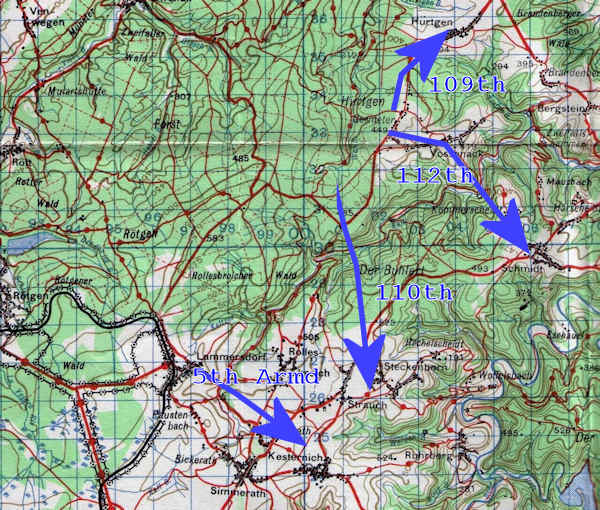in the Hurtgen Forest
Germany, 2 - 14 November 1944
(Rhineland Campaign)
INTRODUCTION
By Major Paul A. Troup, Jr.
In August and September of 1944 the American Legions which spearheaded their way across France became blunted and had their points turned back when they hit the Siegfried Line; Germany's West Wall of steel and concrete forts, which the German Engineers had built with their usual thoroughness. Thus, due to the over-extended routes of communication and dwindling supplies the initial penetrations of the defenses of the "Fatherland" were forced to withdraw in the face of ever increasing opposition. Consequently, the now famous "Pursuit Phase" of World War II was terminated and the coordinated assault phase initiated. 1

Map A
After the fall of Aachen the United States First Army planned an attack early in November on Cologne and the Rhine River. (See Map A) This major attack by VII Corps was to be preceded by a preliminary assault by V Corps on the road center at Schmidt, Germany; securing the high ground northeast and southeast thereof; and seizing two large dams on the Roer River northwest of Gemünd. The imperativeness of this mission was based on the fact that the Germans by systematically destroying or controlling the sluice 'gates of the dams could flood the lower Roer River Valley, consequently placing an obstacle in front of the attacking VII Corps that would be extremely difficult and costly to surmount. It was estimated that the blowing of these dams would make the Roer River to the north impassable from 3 to 6 weeks. 2
At the beginning of this attack the front in the zone of V Corps operations was held by the US 9th Infantry Division whose line extended south from Schevenhütte through the Hürtgen and Roetgen Forests. In numerous small operations this division had suffered heavy casualties; therefore, relief for rehabilitation and reorganization was deemed necessary so that the unit could regain its full fighting effectiveness. 3
THE V CORPS PLANS FOR THE ATTACK
The V Corps plan of operations was presented in Field Order Number 30, dated 21 October 1944, and the supplementary orders and letters of instruction that followed. In this plan the US 28th Infantry Division would relieve the US 9th Infantry Division. The 28th Infantry Division was then assigned the mission of seizing and securing the high ground in the vicinity of Schmidt and Vossenack and establishing contact with VII Corps on the north. The 28th Division would then attack southwest seizing the general line: Lammersdorf - Rollesbroich - Strauch - Steckenborn so that Combat Command "A" of the US. 5th Armored Division with the 2nd Ranger Battalion attached could launch an attack from Lammersdorf to capture the Kesternich - Simmerath line after which time the 28th Division would secure it. The reinforced combat command would then mop up all enemy resistance north of the Roer River. 4 (See Map B-1)

Map B-1
In the preliminaries of the attack the 28th Division would, after being relieved by elements of the US 4th Infantry Division, move into assembly areas northeast of Rott, Germany, and be prepared to relieve the 9th Infantry Division on the 25 and 26 October 1944 at 1530 hours. The division front line ran north and south with the three regiments on line as follows: 109th Infantry Regiment on the north, 110th Infantry Regiment on the south, and 112th Infantry Regiment in the center. The date for the attack was originally scheduled for the 31 October but was made flexible so as to conform with the ammunition requirements and the weather. While awaiting favorable conditions the regiments were training, consolidating positions, and policing the area of dead and abandoned equipment. The ferociousness of the skirmishes in which the 9th Infantry-Division had been engaged was evidenced by the dead who,by their positions, told the story in mute testimony. Paralleling the build-up of men and ammunition, the artillery began indoctrinating the enemy by its program of counter-battery, harassing, and interdictory fires. 5

